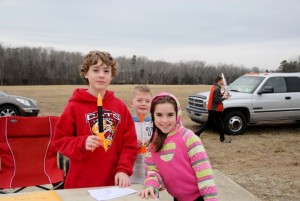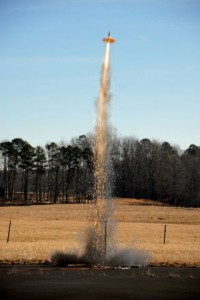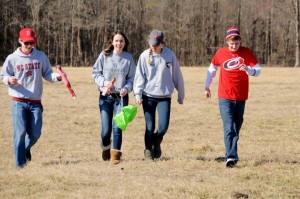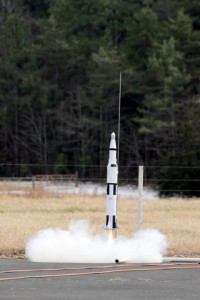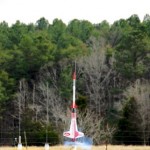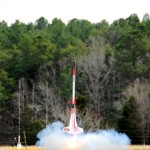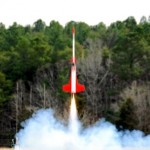Sometimes you just get lucky!!? Back in the fall, we scheduled a low-power event at Butner for the weekend after our annual Astronomy Days exhibition at the Museum of Natural Sciences in Raleigh.? The idea was that any interest among families with children interested in rocketry could be translated into action easier if the next launch were closer, both in time and geographically.? Thanks to a fortunate ?break with the weather in February, that idea turned out to be a real winner!? We had at least 60 people on site for most of the day, at least 30 cars, and the flight cards listed 102 flights for the day!The motor size distribution breaks down as follows:
| Motor | No. |
| ? A | 1 |
| A | 11 |
| B | 17 |
| C | 23 |
| D | 7 |
| E | 9 |
| F | 22 |
| G | 8 |
| H | 4 |
| Total | 102 |
All of you who are reading one of our launch reports for the first time will need to know that the total number in the table, 102, is the total number of flights, and that rockets using more than one motor, either for staging, air-starts, or clustered launches, are classified by the total installed motor impulse.? For example, Andrew Billin flew his Nike-Ajax on a cluster of 3 D12 motors.? The total impulse of that combo is in the F range, so that flight is tallied under the F motor flights.? By the same convention, Dave Morey?s flight of his Big Daddy Cluster was made by ground-starting an F39 and air-starting five D5?s.? The impulse total on this flight added up to a G motor, so it is classified as one of the G motor flights.
The question on everybody?s lips at this point is obviously, ?who flew the 1/2A??? That distinction goes to the man who made this whole weekend possible, the NCSU faculty member who smoothed the way with the Butner Beef Cattle Research Facility management (Part of the NCSU College of Agriculture), to allow us to use Perkins field on this weekend: Professor Chuck Hall.? Chuck flew his Semroc Astron Scout on a 1/2A6 using tumble recovery.
The big news was the huge number of families who joined us for the first time and flew some rockets at a big, organized club launch.? Just a quick glance through the flight cards made this very clear:?? Elizabeth, John and Mitchell Amoroso were there, as were the Woolley sisters, Sarah and Katrina.? Lili and Harrison Delfs flew a bunch of rockets, as did Armand and Elio LoBuglio, Carter and David Lapp, Ethan and Lucas Aufhammer, and Sam and Matt Scholer.? A young man named Aidan, whose last name did not appear on the launch cards, also had 3 very successful flights.
In addition to these families of young flyers and their parents, there were quite a few seasoned veterans, some of whom have never flown with the NC group before.? It was a great pleasure to meet Don Hill, who moved here from Ohio recently, and brought a small flotilla of vintage rockets for our entertainment.
Tripoli East NC regulars Ed and Sonya Winters, Steve Polk, Paul and Aaron Schaefer, and Andrew Billin also showed up to show the crowd what could be done with the smaller motors in the hobby rocketry armamentarium.
The loudest, and perhaps the most exciting flights of the whole weekend were made by Jim Scarpine, who put on an absolute ?Skidmark? blitz, flying a lot of different saucers and other high-drag devices on the fabulously showy sparky motors in the G and H range.? Most of the first-time attendees had never seen or heard a ?skid-mark? motor before, and a lot of them jumped straight up in the air the first time one of Jim?s rockets was launched!
The flight cards also revealed another surprise.? There were only seven D motor flights recorded all day, and two of those were made by clusters or staged rockets that added up to D impulse level.? The only five D motors flown alone were flown by Mike Collier, who flew 2 of them, and Ed Withers, Aaron Schaefer, and Ron Hill.? This was surprising to me, because I had visited the field before, and it looked like a great D and E motor location to me, with E motors being perfect for the larger and heavier rockets.? When the big day actually arrived, there were a lot of flyers who were a lot braver than I would have been.
We had two TARC teams from Jordan High School show up to work on their rockets for this year?s challenge, and I recall a very high success rate for these flights.??One
team was flying a rocket named Buttercup, which was painted a very un-buttercup colored pink, and the other team was flying a rocket called American Eagle that was completely lacking paint.
One of the rarest events at a rocket launch is an occasion when someone who has actually taken the time and effort to complete one of the beautiful ESTES Saturn V models will decide to fly the rocket.? This Saturday, Steve Polk decided to take the plunge, installing a pair of E9 motors for the flight.? There did not seem to be enough nose weight in this version, because the rocket did a few circles in the sky and landed without benefit of parachute.? The damage was slight, but Steve will probably not put motors in that model again.
The members of Tripoli East NC are all grateful to all of you who showed up to make this a great event, both the flyers and the folks who actually did the work of organizing and directing the launch activities:? Dave Morey, in particular, with a lot of help from Scott Schnegelberger, Dave Hash, and Chuck Hall.? You made it work.
Alan Whitmore
Prefect, Tripoli East NC

